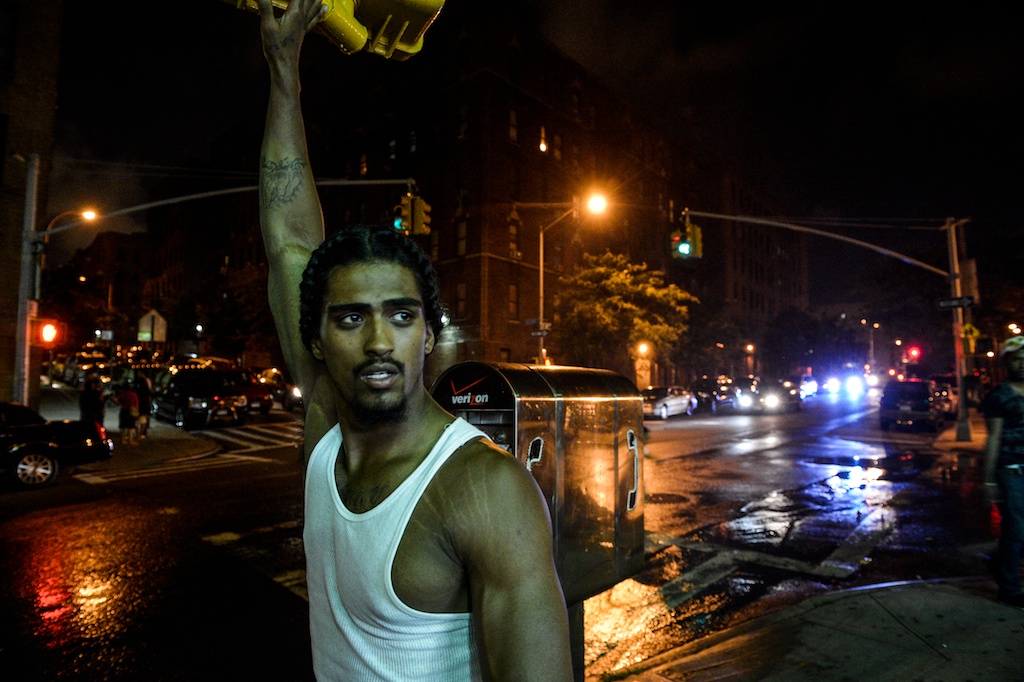
Robert Stolarik / JJIE
August 4, 2012 - Bronx, N.Y: Joel Rodriguez, a neighborhood resident who has been victim to stop and frisk policies.
NEW YORK -- The streets are about to become safer -- from both the police and from criminals -- for black and Latino teens who have been increasingly subjected to routine stop and frisks by the New York City Police Department, thanks to a federal court ruling on Monday that declared the NYPD’s application of the program unconstitutional, activists said.
 In her decision, Judge Shira A. Scheindlin wrote that police violated plaintiffs’ constitutional rights by conducting searches without reasonable suspicion and disproportionately targeting young men of color.
In her decision, Judge Shira A. Scheindlin wrote that police violated plaintiffs’ constitutional rights by conducting searches without reasonable suspicion and disproportionately targeting young men of color.
Slowing down stop and frisk may mean positive changes in the long run for teens. A recent study from the University of Missouri in St. Louis showed that it is unlikely the program acted as a deterrent to young men in regards to future crimes. In fact, the study argues, encounters with police could lead to increases in subsequent delinquent behavior and fewer feelings of guilt.
Research on adolescent brains does not support the argument that stop and frisk served as a deterrent to young men considering committing crimes, said Stephanie Wiley, a graduate research assistant at UMSL who worked on the study.
“They’re not as worried about thinking of long-term or even short-term consequences,” Wiley said. “That’s just due to development of the brain. The prefrontal cortex doesn’t fully develop until the mid to late 20s.”
Frenny Pena, 20, had been stopped three times in the last week, he said. Pena is a resident of East Williamsburg and father of two. He and his friends feel they are routinely targeted because of where they live.

Mary Shell / JJIE
From left to right: Frenny Pena, 20, unknown, and Cord Sanchez, 25, discussing the impacts of stop and frisk practices with the author.
“I’m a working boy -- I ain’t got no deals in the street or nothin,” he said. “I can stand on the corner right now, do this interview with you and they will stop us.”
Judge Scheindlin ordered a number of immediate changes to the program, including body-mounted cameras to be worn in certain precincts, a collaborative review process to engage the NYPD with community leaders and an independent monitor to track the NYPD’s compliance.
Pena was skeptical about the pilot program requiring some officers to wear cameras on their uniforms, but encouraged by the appointment of an independent monitor.
“Tell [the judge] I said thank you,” Pena said. “Cuz that’s what we need right now; especially in New York City.”
Data presented in the case showed that since January of 2004, the annual number of stops more than doubled, to over 680,000 people in 2011. More than 80 percent of people stopped were black and Hispanic.
Yet Mayor Michael Bloomberg and Police Commissioner Ray Kelly remained defiant against findings that the practice had been used in a way that discriminated against New York City’s young men of color.
“That simply is recklessly untrue,” Kelly said during a press conference on Monday. “We train our officers that they need reasonable suspicion to make a stop, and I can assure you that race is never a reason to conduct a stop.”
Lack of appropriate training is a known problem, said Delores Jones-Brown. Jones-Brown is professor at John Jay College of Criminal Justice. She estimated that she instructed upwards of 2,000 sworn officers over the last 10 years at a leadership academy for the NYPD.
“Even rookie officers are given a mandate to go out into certain communities to stop people who they think are suspicious,” she said. “But they haven’t been given any good guidance as to the legal or legitimate means of making a determination of who is suspicious.”
The Mayor insisted that the NYPD has saved countless lives by using proactive policing tactics, and indicated that the city would appeal the ruling. But Jones-Brown said it is extremely unlikely a court would overturn Monday’s ruling.
“The data is so heavily against the [police] department, I would be shocked if the court would overturn Judge Scheindlin’s ruling,” she said.
Attorney Samuel Cohen’s private practice focuses primarily on police misconduct. Cohen believes that wearing cameras during patrol will improve the manner in which officers do their jobs.
“It will also provide a more perfect channel of information showing police encounters with civilians,” he said.
Scheindlin’s choice for an independent monitor does not have an axe to grind with the NYPD, Cohen said.
“Peter Zimroth is extremely well known and well respected in the New York legal community as someone who is impartial and fair,” Cohen said. “He is certainly not biased against the NYPD in any way.”
Cohen said that even if the reforms outlined in Judge Scheindlin’s ruling do not solve the NYPD’s difficulties with race, “the information gathered over the course of this action are of incredible use and value to the community.”
No matter what, New York City needs to do a better job of training our officers to detect crime as it’s about to happen, Jones-Brown said.
“Law abiding people have the right to walk on the public streets without being interfered with by the police ... regardless of what they look like, regardless of how they dress and regardless of where they live,” Jones-Brown said. “That is a fundamental right.”
